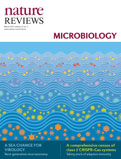|
Advertisement | |||||||||||||||||||||||||||||||||||||
| |||||||||||||||||||||||||||||||||||||
| TABLE OF CONTENTS | |||||||||||||||||||||||||||||||||||||
| March 2017 Volume 15 Number 3 | |||||||||||||||||||||||||||||||||||||
| In this issue
| ||||||||||||||||||||||||||||||||||||
| |||||||||||||||||||||||||||||||||||||
 | |||||||||||||||||||||||||||||||||||||
| Advertisement | |||||||||||||||||||||||||||||||||||||
| |||||||||||||||||||||||||||||||||||||
| Advertisement | |||||||||||||||||||||||||||||||||||||
| |||||||||||||||||||||||||||||||||||||
| EDITORIAL | Top | ||||||||||||||||||||||||||||||||||||
| A sea change for virology p129 | doi:10.1038/nrmicro.2017.13 This issue marks the publication of a Consensus Statement that proposes the integration of viruses that are only characterized by metagenomic data into virus taxonomy. Full Text | PDF | |||||||||||||||||||||||||||||||||||||
| |||||||||||||||||||||||||||||||||||||
| NEWS AND ANALYSIS | Top | ||||||||||||||||||||||||||||||||||||
| GENOME WATCH Finding the needle in the haystack Gavin G. Rutledge & Cristina V. Ariani p136 | doi:10.1038/nrmicro.2017.7 This month's Genome Watch discusses the potential of selective whole-genome amplification for overcoming the challenges of whole-genome sequencing of malaria parasites in clinical samples in which they are low in abundance. | |||||||||||||||||||||||||||||||||||||
| REVIEWS | Top | ||||||||||||||||||||||||||||||||||||
| Hit the right spots: cell cycle control by phosphorylated guanosines in alphaproteobacteria Régis Hallez, Marie Delaby, Stefano Sanselicio & Patrick H. Viollier p137 | doi:10.1038/nrmicro.2016.183 Recent studies have provided insights into the antagonistic roles of cyclic-di-GMP (c-di-GMP) and the alarmones guanosine tetraphosphate and guanosine pentaphosphate (collectively referred to as (p)ppGpp) in the regulation of the cell cycle in Alphaproteobacteria. In this Review, Viollier and colleagues discuss how those second messengers control the initiation of DNA replication and cytokinesis by modulating the synthesis and proteolysis of key regulators of the cell cycle. Abstract | Full Text | PDF | |||||||||||||||||||||||||||||||||||||
| A journey into the brain: insight into how bacterial pathogens cross blood-brain barriers Mathieu Coureuil, Hervé Lécuyer, Sandrine Bourdoulous & Xavier Nassif p149 | doi:10.1038/nrmicro.2016.178 Bacteria have to overcome many obstacles to invade the meninges from the bloodstream. This Review considers how extracellular pathogens such as Neisseria meningitides and Streptococcus pneumoniae bypass the blood-brain barriers, the understanding of which may lead to improved methods for delivering drugs into the brain. Abstract | Full Text | PDF | |||||||||||||||||||||||||||||||||||||
| CONSENSUS STATEMENT | Top | ||||||||||||||||||||||||||||||||||||
| Consensus statement: Virus taxonomy in the age of metagenomics Peter Simmonds, Mike J. Adams, Mária Benkő, Mya Breitbart, J. Rodney Brister, Eric B. Carstens, Andrew J. Davison, Eric Delwart, Alexander E. Gorbalenya, Balázs Harrach, Roger Hull, Andrew M.Q. King, Eugene V. Koonin, Mart Krupovic, Jens H. Kuhn, Elliot J. Lefkowitz, Max L. Nibert, Richard Orton, Marilyn J. Roossinck, Sead Sabanadzovic, Matthew B. Sullivan, Curtis A. Suttle, Robert B. Tesh, René A. van der Vlugt, Arvind Varsani & F. Murilo Zerbini p161 | doi:10.1038/nrmicro.2016.177 Although viral sequences are important in taxonomy, classification has typically also required biological properties, thus excluding viruses that were identified by metagenomics. The proposals in this Consensus Statement, which are supported by the International Committee on Taxonomy of Viruses (ICTV), enable viruses that are discovered by sequence alone to be incorporated into virus classification. Abstract | Full Text | PDF | Supplementary information | |||||||||||||||||||||||||||||||||||||
| ANALYSIS | Top | ||||||||||||||||||||||||||||||||||||
| Diversity and evolution of class 2 CRISPR-Cas systems Sergey Shmakov, Aaron Smargon, David Scott, David Cox, Neena Pyzocha, Winston Yan, Omar O. Abudayyeh, Jonathan S. Gootenberg, Kira S. Makarova, Yuri I. Wolf, Konstantin Severinov, Feng Zhang & Eugene V. Koonin p169 | doi:10.1038/nrmicro.2016.184 Class 2 CRISPR-Cas systems are characterized by effector modules that consist of a single multidomain protein. In this Analysis, using a computational pipeline, the authors discover three novel families of class 2 effectors that correspond to three new CRISPR-Cas subtypes and present a comprehensive census of class 2 systems that are encoded in complete and draft bacterial and archaeal genomes. Abstract | Full Text | PDF | Supplementary information | |||||||||||||||||||||||||||||||||||||
| PERSPECTIVES | Top | ||||||||||||||||||||||||||||||||||||
| OPINION Clinical and biological insights from viral genome sequencing Charlotte J. Houldcroft, Mathew A. Beale & Judith Breuer p183 | doi:10.1038/nrmicro.2016.182 Sequencing viral DNA and RNA is an important part of clinical practice, although, so far, mostly subgenomic fragments have been sequenced. In this Opinion article, Houldcroft, Beale and Breuer highlight the potential that sequencing whole viral genomes has for clinical applications. Abstract | Full Text | PDF | |||||||||||||||||||||||||||||||||||||
| |||||||||||||||||||||||||||||||||||||
You have been sent this Table of Contents Alert because you have opted in to receive it. You can change or discontinue your e-mail alerts at any time, by modifying your preferences on your nature.com account at: www.nature.com/myaccount For further technical assistance, please contact our registration department For print subscription enquiries, please contact our subscription department For other enquiries, please contact our feedback department Nature Publishing Group | One New York Plaza, Suite 4500 | New York | NY 10004-1562 | USA Nature Publishing Group's worldwide offices: Macmillan Publishers Limited is a company incorporated in England and Wales under company number 785998 and whose registered office is located at The Campus, 4 Crinan Street, London, N1 9XW. © 2017 Nature Publishing Group, a division of Macmillan Publishers Limited. All Rights Reserved. |
 |









No comments:
Post a Comment